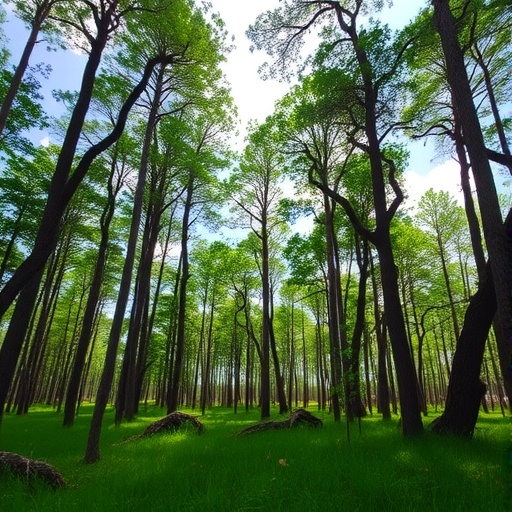In the relentless quest to combat climate change, reforestation has emerged as one of the most promising natural climate solutions. However, accurately estimating the global potential for reforestation as a mitigation strategy remains an intricate scientific challenge. A recent groundbreaking study by Fesenmyer, Poor, Terasaki Hart, and colleagues, published in Nature Communications in 2025, addresses this very challenge by critically examining and refining previous global estimates of reforestation potential. This work not only advances the methodological framework but also provides a more nuanced understanding of how reforestation can realistically contribute to climate mitigation efforts on a planetary scale.
The significance of reforestation is multifold. Forests play a pivotal role in sequestering carbon dioxide, a major greenhouse gas driving anthropogenic climate change. Trees absorb atmospheric carbon during photosynthesis and store it in biomass and soil, acting as carbon sinks. Nevertheless, global assessments of how much land can be feasibly reforested without compromising food security, biodiversity, or land rights have varied widely, often sparking debate among scientists and policymakers alike.
Central to Fesenmyer and colleagues’ approach is the meticulous addressing of critiques that have previously challenged optimistic reforestation projections. These critiques have underscored that many earlier studies underestimated ecological, social, and economic constraints, thus inflating potential carbon capture figures. By engaging with these critical perspectives, the authors have sought to produce estimates that are not only scientifically robust but also socioeconomically sensitive.
One core advancement made in this research is the incorporation of fine-scale land-use data and updated ecological parameters into large-scale models. Traditional global models often rely on coarse datasets that gloss over local heterogeneities in land ownership, soil suitability, and climatic conditions. The new methodology integrates high-resolution remote sensing data with ground-truth observations, allowing for a precise differentiation between lands viable for reforestation and those better suited for agriculture or natural habitats.
Importantly, this enhanced framework differentiates between passive and active reforestation strategies. Passive reforestation relies on natural regeneration processes, which can be unpredictable and slow, whereas active reforestation involves intentional tree planting and management. The study quantifies carbon sequestration timelines and maximum potential biomass accumulations for various reforestation approaches, offering policymakers detailed insights into trade-offs and planning horizons.
Another critical factor the authors have considered is the interplay between climate change itself and reforestation potential. Changing temperature and precipitation patterns affect tree growth rates, species distributions, and the risk of disturbances such as wildfires and pests. By integrating climate projection scenarios into their models, the researchers provide dynamic estimates that adjust reforestation potential over the coming decades, rather than static snapshots.
Social constraints emerge as an equally salient theme in this work. The land available for reforestation is, in reality, often subject to competing interests—from indigenous communities, agricultural economies, urban sprawl, to biodiversity conservation. The authors emphasize that reforestation must proceed in ways that respect land tenure rights and maintain food production to avoid unintended negative consequences, such as displacement or food insecurity.
The study also engages with the carbon accounting methodologies employed in global climate frameworks like the Paris Agreement. By refining carbon stock calculations with more realistic estimates of growth rates, forest density, and permanence, the research contributes to more credible reporting and verification systems. This is paramount for countries and organizations that seek to include reforestation in their Nationally Determined Contributions (NDCs).
Technically, the research leverages advanced geospatial analytics powered by machine learning algorithms. These allow for the classification of land cover and disturbance histories at unprecedented accuracy. The integration of socio-economic datasets, including rural demographics and land tenure records, adds a critical human dimension often neglected in purely ecological studies.
One particularly intriguing result is the revelation that while the global area suitable for reforestation has shrunk compared to earlier optimistic estimates, the carbon sequestration potential remains substantial when precisely targeted. This finding advocates for strategic, location-specific restoration projects rather than broad-brush afforestation schemes, thus maximizing ecological benefits and carbon uptake efficiency.
Furthermore, the research highlights the essential role of biodiversity in reforestation projects. Planting monocultures, while simpler and faster, can undermine ecosystem resilience and long-term carbon storage. The authors advocate for mixed-species plantations that mimic natural forests, which bolster habitat connectivity and provide co-benefits such as soil stabilization and water regulation.
The anticipated impacts of this refined understanding ripple into climate policy, conservation priorities, and investment strategies. Governments and private entities can leverage these improved models to optimize reforestation budgets and maximize climate returns. Additionally, the study provides a compelling case for increased international cooperation to reconcile environmental goals with social equity.
From a methodological standpoint, the researchers acknowledge ongoing uncertainties and propose avenues for future refinement. Continuous monitoring of restored sites, integration of emerging data from earth observation satellites, and participatory mapping with local stakeholders will enhance the reliability and inclusivity of future estimates.
Summing up, this pivotal contribution by Fesenmyer et al. redefines the science of reforestation potential by bridging ecological realities with social complexities and technical innovation. Their work serves as both a reality check and an inspiration, clarifying what forests can deliver in the global climate mitigation arsenal—and how best to cultivate that potential responsibly.
In a world grappling with urgent climate objectives, the message is clear: maximizing the benefits of reforestation demands rigor, nuance, and collaboration across disciplines and sectors. As policymakers, scientists, and communities align on these refined estimates, the prospects for harnessing forests in the fight against climate change become all the more tangible and hopeful.
Subject of Research: Estimating and refining global reforestation potential for effective climate change mitigation by addressing ecological, social, and methodological critiques.
Article Title: Addressing critiques refines global estimates of reforestation potential for climate change mitigation.
Article References:
Fesenmyer, K.A., Poor, E.E., Terasaki Hart, D.E. et al. Addressing critiques refines global estimates of reforestation potential for climate change mitigation.
Nat Commun 16, 4572 (2025). https://doi.org/10.1038/s41467-025-59799-8
Image Credits: AI Generated




